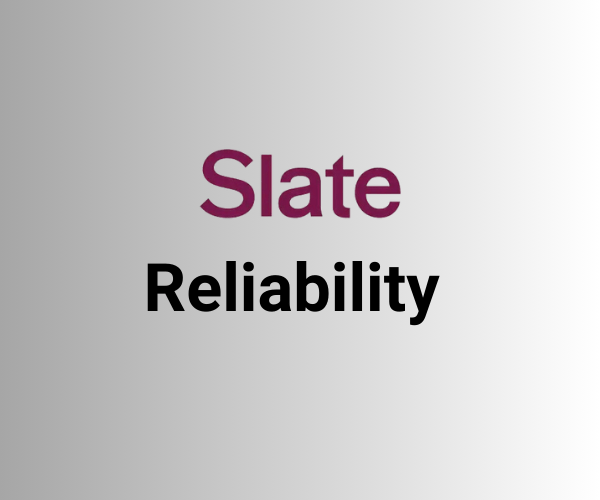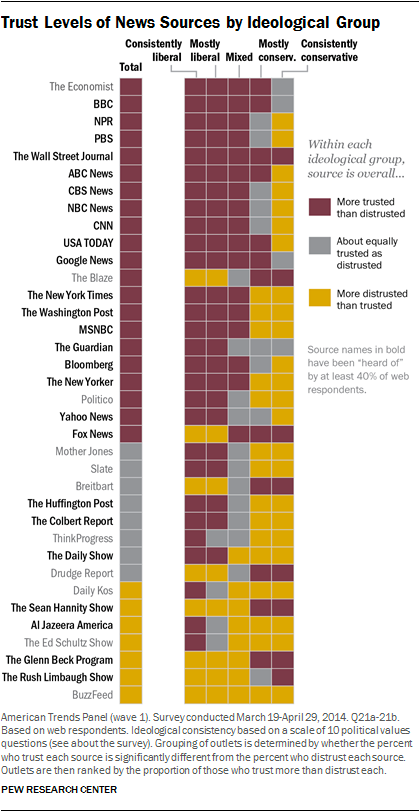
In 2014, Pew Research found that only 31% of those who could rate Slate Magazine gave it a three or four credibility rating (out of four). The other ratings below this standard express that the audience believes almost none or very little of the information being provided. That being said, a relatively small group of people were able to rate Slate in this circumstance. Pew also looked at trust levels broken down by ideological groups, where Slate was found to be about equally trusted as distrusted among a majority of readers. Its liberal audience tended to place more trust in its reporting, while conservative groups exercised more caution.

Source: Pew Research
Does Reliability Matter?
Reliability, in general, refers to how trustworthy or accurate information, or in this case, a news source is. If we consider this definition, it quickly becomes clear why reliability is important in media sources. If we can’t trust the things we read then there isn’t much of a point in continuing to consume content from that source, after all. So how exactly can we gauge the reliability of a news source anyways?
There are several potential measures of reliability to look out for when trying to determine whether a media source is reliable or not. Red flags for an unreliable article can include the presence of wild unsubstantiated claims, facts dependent on other unreliable sources, heavy use of opinionated language, and more. Some indicators of a reliable news source, on the other hand, include things like:
- Absence of subjective/opinionated language in articles
- Credible sources cited (e.g., neutral sources, .gov, .edu websites)
- Facts and statistics backed by multiple relevant outside sources
- Use of primary sources when possible (e.g., interviews, quotes)
- Information that remains consistent across news sources
How Does Slate Fare in its Reliability?
Biasly uses an independently developed political bias index to evaluate the reliability of different news sources. Reliability is calculated by observing the quality of each source and analyzing the diversity and uniqueness of its quotes. Its Analyst rating and A.I reliability rating for Slate both fall into the “Fair,” or Grade C category. Other third party rating methods have come to similar conclusions, especially given Slate’s bias. As these are composite scores, the reader must be aware that different articles are always subject to various levels of credibility.
Slate Accuracy and Reliability
The dependability of news sources is heavily affected by the inclusion of political bias. Slate has been known to incorporate left-leaning bias and ignore right-leaning perspectives. This particular bias has been acknowledged by both readers and staff members. Despite this, it is still necessary to observe further evidence to confirm these accusations. We will focus specifically on selection and omission bias as we analyze the factuality of several different articles.
Selection bias is when stories and facts are selected or deselected, often on ideological grounds, to create a narrative in support of the news sources’ ideology. Omission bias, on the other hand, is when different opinions and political views regarding a situation are left out so that the reader is only exposed to the ideological perspective supported by the author. It’s important to keep in mind these two types of biases when trying to assess an article’s level of accuracy.
Biasly assigns a percentage score to accuracy ranging from 1-100, with one being the least accurate and one hundred being the most reliable. The scores are determined by analyzing the number of claims supported by evidence, and the number of credible internal and external sources utilized. Biasly’s website provides a complete breakdown of reliability ratings for Slate. Again, while the overall reliability (according to our analysts) is categorized as “Fair”, each article’s level of bias is different, with the largest variations surrounding omission and selection. Slate is one of many news sources that incorporates left-leaning bias, but there are other organizations that favor conservative politics. For example, American Thinker is rated by Biasly as being “Extremely Conservative” with a “Fair” reliability rating. Despite this overall score, there are articles that have higher ratings, such as “Cheaters Shouldn’t Win and Winners Shouldn’t Cheat,” which received an “Excellent” reliability rating. On the other end, “Biden is falling apart among five key demographic groups -TIPP poll” received a “Fair” rating (especially in regard to using multiple unique sources), with opposite sources and quote length being labeled “Poor.” Both pieces were categorized as “Extremely Conservative”, showcasing that bias and credibility differ between articles and news sources that favor varying political agendas.
Let’s now look at an article found on Slate that demonstrates selection and omission bias. The article “The Democrats Are Falling Into a Trap on Immigration Again,” by Pedro Gerson is rated as “Center” by Biasly’s News Check Chrome Extension, but leans slightly to the right. The author does well to describe the situation happening at the border between Mexico and the United States. However, they do not focus specifically on statistics or information coming from Customs and Border Protection. The arguments of those supporting stricter immigration policies are generally omitted from this article. The author also selects certain individuals who favor these policies to criticize their behavior and decision-making.
“Moving to what’s happening in the United States, although last year recorded the highest numbers of arrivals on record, Customs and Border Protection has five times the budget it used to have in 2000, during the previous peak, so it’s hard to believe the agency’s claims that they’re simply overrun. In short, yes, there is more immigration to the U.S., but it’s not at a level that corresponds to the political frenzy or justifies the rightward shift of the Biden administration.”
While there are opinionated statements in the article, there is also a degree of objective reporting in which the author attempts to explain the shifting immigration policies under President Biden’s administration. The left-leaning bias is still apparent in several ways, namely through the selection of points that favor ideals of the Democratic party and the omission of facts surrounding practical effects of immigration laws. These elements reduce the reliability of the article.
More examples will be examined below as we continue to look at the reliability of Slate’s news.
Analysis of Reliability in Slate Opinion Pieces
Opinion pieces are published in many news organizations, as it allows authors to express personal beliefs on particular subjects. This style of journalism can be detrimental if it is too extreme, and it is less dependable due to its subjectivity. Analyzing these articles is important in understanding different viewpoints as long as the reader understands the incorporated bias.
Slate’s website includes many opinion pieces, a majority of which concern current domestic political topics. The language in these articles is typically very leading and evokes strong emotional responses, and there is usually a lack of opposing perspectives. The article “The Law Alone Cannot Curb Donald Trump’s Lawlessness,” by Dahlia Lithwick is one such example. This piece focuses on Trump’s legal trials with diction that strongly disapproves of the former president and his tactics.
“Should we run our democracy based on such potential threats, and more abstractly: Should judges presiding over the myriad Trump trials that the former president uses to incite stochastic terror and demean the judicial system allow him to speak freely? Or should they make every effort to limit his use of their courtrooms as campaign stops and hate rallies?”
The language utilized by Lithwick encourages a negative overview of the former president and discourages productive debate from conservative individuals.
Quality of Sources and Facts Used
Slate is capable of producing reports that address both sides of the political spectrum with evidence and credible sources; however, there are still articles that fall short of this goal. One of the ways reliability is analyzed is by looking at the number of quotes, their length, and the sources they were pulled from. The article “Congress is Struggling to Keep the Government Funded. Why are Republicans Spending $40K on Pins?” is an example of an opinion piece that negatively portrays Republican members of Congress. There are ten quotes included in this report, with eight short and two medium. The primary sources either referenced or quoted are below:
- Illinois Representative Sean Casten (Democrat)
- NC Representative Deborah Ross (Democrat)
- Former California Representative Sam Farr (Democrat)
- Speaker Emerita Nancy Pelosi (Democrat)
- Daniel Engber (former columnist for Slate)
- Huffpost (Moderately Liberal)
- Semafor (Leans Left)
Upon first glance, the number of quotes is promising; however, the quality leaves room for improvement. While many of the quotes are from reputable sources, namely different members of the House of Representatives, the short length and opinionated nature of the quotes diminishes their reliability. Most of the quotes do not address statistical facts, instead using rhetoric that would encourage an emotional response.
“Today we’re getting a new pin, half way through the term because the House GOP didn’t like the color. Big congrats to them on their first tangible accomplishment of the 118th” (Rep. Sean Casten).
Author Shiri Ali also only quotes representatives that belong to the Democratic Party (Casten, Ross, Farr, and Pelosi). The article references two other news sources as well: Huffpost and Semafor. Both of these organizations have a liberal bias, which supports the agenda that is typically found on Slate. Representative Ross’s quote was pulled from an article on Huffpost, which is individually rated as being “Moderately Liberal” by Biasly’s A.I. News Check Chrome Extension. There is a complete absence of opinions from members of the Republican Party, encouraging a one-sided reading of this piece. The only support for the pins came from Representative Farr, who said:
“They allow members of Congress to “fast-track through security,” California Rep. Sam Farr told Roll Call back in 2005. The pins are viewed as a “token symbolic of their public service,” he said. “Whether they wear them or not, they’re proud to be entitled to have one.”
There are several other sources mentioned in this article; namely, The Hill, The New York Times, Politico, Huffpost, Semafor, Roll Call, Axios, and Twitter. The number of outside sources is substantial, but the references all tend to have liberal leanings, which can be confirmed on Biasly’s media bias rating list, decreasing the overall diversity. Conservative sources are not included, again demonstrating bias and undermining the overall trustworthiness of the article. The only positive sentiment expressed was the aforementioned quote by Sam Farr.
The previously mentioned article, “The Law Alone Cannot Curb Donald Trump’s Lawlessness” also shows a lack of quality sources, as it relies primarily on opinion to promote an agenda. The only quote included is a short one from journalist Jeff Sharlet, whose clear anti-Trump rhetoric can be found in his social media. The quote reads:
“The one thing Trump has made clear is we don’t know yet how to stop Trumpism.”
Sharlet’s quote does not contribute to the content of the article, nor does it express a level of objectivity. Experts and individuals directly involved in this process were not quoted, and the article overlooks right-leaning viewpoints. It also does not provide a comprehensive background of the trials, and if the reader had little to no previous knowledge, the likelihood increases that they would be swayed by the language of this piece.
Much of the information given in the article is opinion disguised as fact. One example of this reads:
“We are in an existential battle to save democracy from the single most profound threat it has faced since at least the Civil War.”
The threat specifically being referenced here is the potential re-election of Donal Trump to the presidency. The author then uses this to describe the alleged declining integrity of the American legal system. While there are several other sources referenced, they are from organizations that also tend to have a left-leaning bias. These include The New Yorker, New York Times, Vanity Fair, the Guardian, AP News, and other Slate articles. The pieces mentioned support the author’s claims, hindering objective and factual reporting.
Selection and Omission Bias
These types of bias are not only present in liberal articles. For example, “Biden’s Admission About His Airstrikes on the Houthis Is Unbelievable” speaks negatively about several of President Biden’s actions. An article of this nature is unusual from Slate, but must still be analyzed appropriately. There is only one quote, a short sentence from Biden, mentioned here. The quote, given in response to the question “Are the airstrikes in Yemen working?” is as follows:
“Well, when you say ‘working’—are they stopping the Houthis? No. Are they going to continue? Yes.”
The author, Alexander Sammon, criticizes Biden’s policy concerning the Israeli-Palestinian conflict. He uses extreme language to discredit the president’s choices and decrease confidence in his decision-making capabilities. One example of this reads:
“Nevertheless, while much of Biden’s agenda has been thwarted by political obstacles, he’s had no problem circumventing procedural obstruction to continue support for this war. He’s gone around Congress to transfer more weapons to Israel, and he simply ignored the chamber in his pursuit of airstrikes on the Houthis.”
Towards the end of the article the author states:
“It can sometimes be a struggle to describe Biden’s doctrine on foreign policy. These days, it’s easy to forget that he pulled the U.S. out of Afghanistan early in his first term. Since then, he’s returned, zombielike, to a shortsighted Cold War display of force.”
The first quote is designed to inspire distrust for Biden’s decision to continue airstrikes on the Houthis. The language used, such as “circumventing procedural obstruction” and “ignored the chamber,” evokes a feeling of disapproval. The second quote also incorporates diction that is meant to inspire an emotional response, especially with the word-choice “zombielike” to describe Biden’s current attitude on the war.
While the report attempts to provide context for the conflict, it fails to describe the circumstances that led to the bombing campaign in Yemen that it seeks to condemn. The omission of outside sources and the subjective nature of the article significantly decreases its reliability. The language utilized also clearly indicates a particular bias against the president:
“Joe Biden is not known for pith in his public remarks; he is known for spiraling, ungrammatical sentence construction, digression, and avuncular nonsense.”
To reiterate, selection and omission bias can be found in articles that either favor or oppose ideas from both major political parties. As aforementioned, the article “Congress is Struggling to Keep the Government Funded. Why are Republicans Spending $40K on Pins?” clearly omits right-leaning views, which limits productive political conversation. The inclusion of more conservative sources would have increased the reliability of the article considerably.
Opinion pieces often run into problems with factuality, selection, and omission, and routinely fall short of providing adequate context. Most of the aforementioned articles include a substantial left-leaning perspective (with one exception), and neglect views contrary to the authors’. It is important that readers are aware of these biases so that they are encouraged to find news that addresses all aspects of an issue.
Is Slate Reliable?
After careful analysis, it can be asserted that Slate Magazine is a semi-reliable news source. While it includes many relevant articles, its stated mission to emphasize integrity falls short due to the lack of balance in its reporting. Its emphasis on opinion rather than fact also makes it a less credible resource, and readers should be cautious when consuming information on Slate’s website.
The organization often prioritizes entertainment over unbiased news, which decreases its overall reliability rating. To help eliminate any uncertainty about the biases found in certain articles, readers can run an article through Biasly’s News Checker or download the Biasly News Check Chrome Extension. Individuals should still seek out multiple news sources that incorporate a variety of ideologies to ensure they are forming the most educated opinion.


























